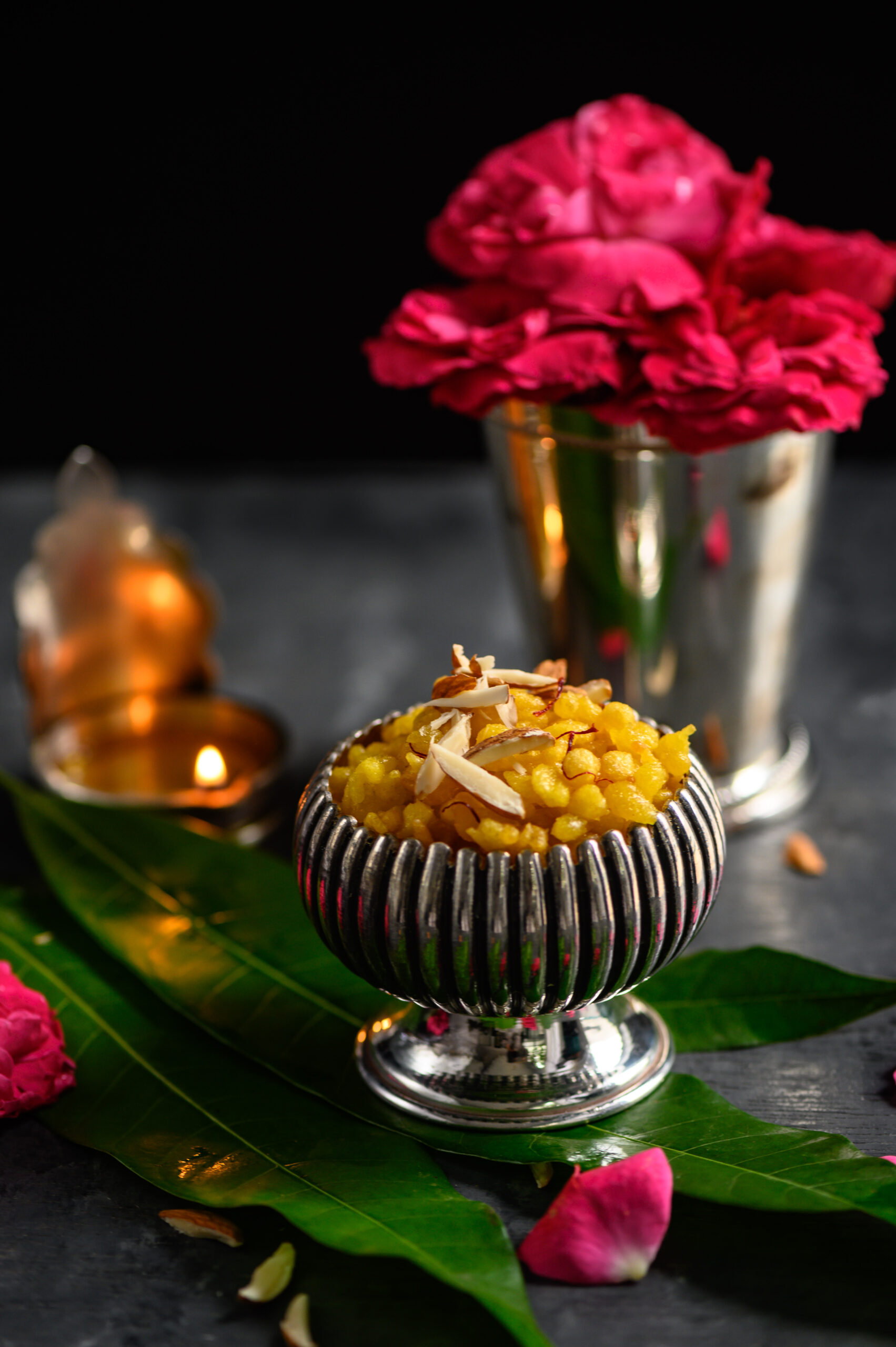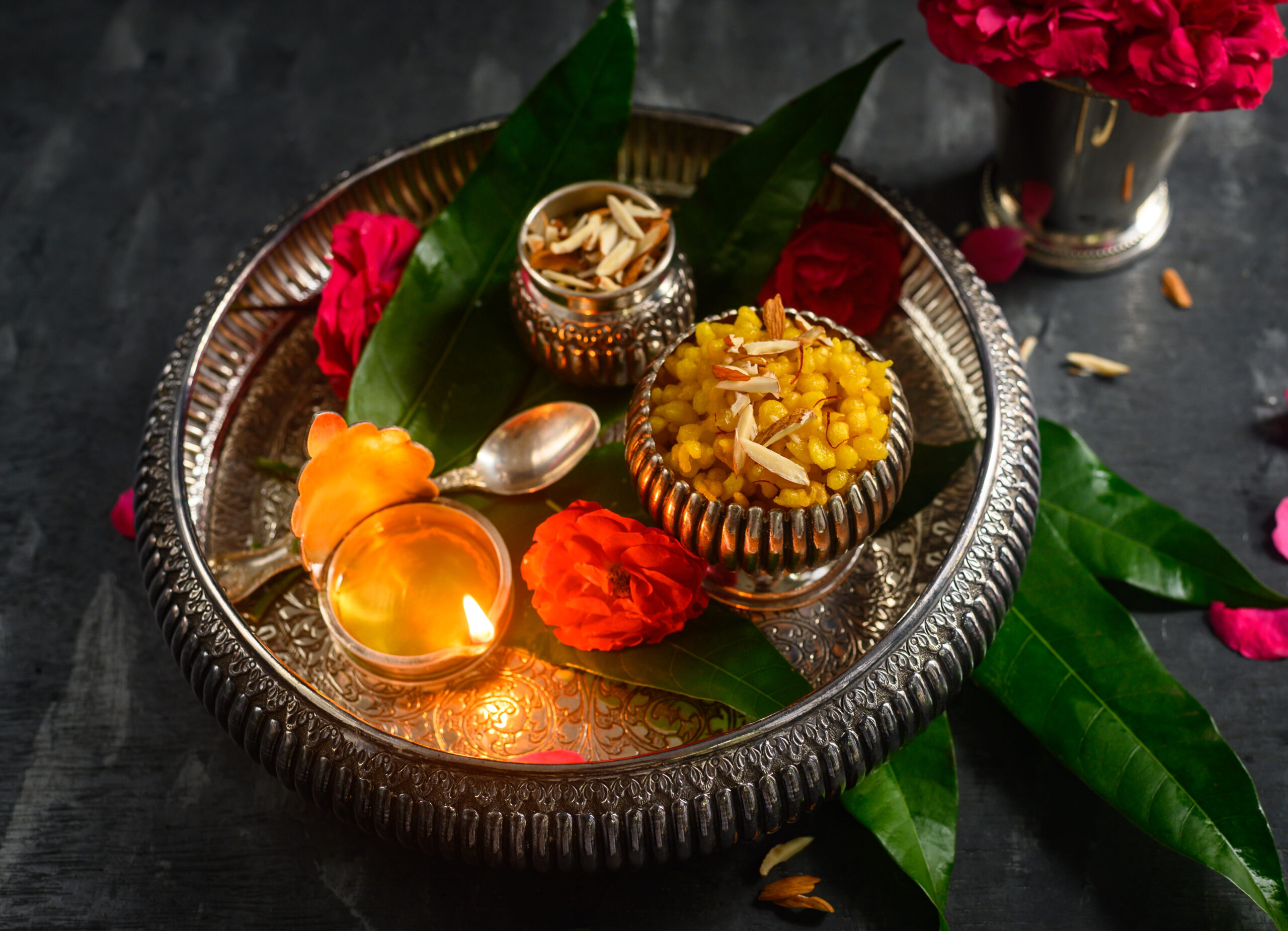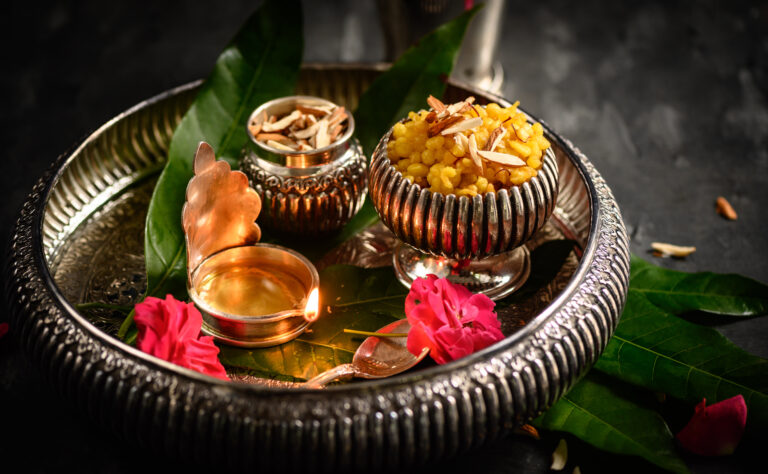This Diwali, in so many homes across India (and in Indian homes across the world), sweets are going to be the star of the celebrations. Among several I am preparing is the sweet boondi, which I only learned how to make recently. Much to my surprise, it was an almost effortless process. Originating from Rajasthani cuisine and also popular in Bengal, boondi is essentially fried balls of chickpea batter, submerged in sugar syrup. It is certainly an indulgence, but that’s what festive seasons are for, aren’t they?
My sister has become my culinary teacher of late, and I was staying with her for a few weeks while having my sciatica treated. You may have noticed that I had been lying low on Instagram for awhile, and that was the reason why. I believe that illnesses have a mind-body connect, and my body forced me to destress through this one. The best advice that anyone gave me was that I needed to enjoy my downtime. I spent my recuperation reading, catching up with films, taking it easy, doing mild exercises which were a far cry from my frantic and intensive gym regimen, and just breathing. We have to remind ourselves to slow down and savour the moment. For those of you watching your diet over the holidays, you know exactly how it feels to let yourself enjoy just one sweet. That’s the kind of slowing down and savouring that I am talking about.
Staying with my sister gave me a chance to watch her working in her kitchen daily, and to pick up so many techniques and recipes from her. Among them was this sweet boondi. Like many people, I had consumed it innumerable times without ever attempting to make it myself.
Boondi is made in different sizes. The tiny one is called “motichoor”, for “moti”, meaning pearl. This recipe can be considered medium-sized. I recall enjoying the large, laddoo version of this sweet as a child (“motichoor laddoo”, in which many small balls are rolled together to make one big one). Another way to make this sweet is to flatten out the batter on a dish and cut it into squares, which are then fried and dipped in sugar syrup just like all the variants.
These days, with the proliferation of sweet stores, I find that many people reach out to purchase a whole range of treats without any idea of how easy they are to make. The soft sandesh that I recently shared on this blog was a perfect example of this. Some of my friends told me after reading the post that they had no idea that an item they had always considered fancy and difficult to make was in fact extremely straightforward and required so few ingredients. We often have the impression that just because something is available for purchase in stores and at restaurants, it cannot be prepared at home. This sweet boondi is similar. Let me assure you that as long as you master the consistency of the batter and the syrup syrup, you’ll be able to whip it up in your own kitchen in no time. The process is quick and easy, not as long-drawn and elaborate as you may have imagined.
Unlike perishable milk sweets, this dish will keep for a few more days – but I guarantee you that you won’t have proof of that. It’s far too irresistible. Place it on the table and just watch it disappear!

Sweet Boondi
(Yield: approximately 3 cups)
1 cup chickpea flour
¾ cup water
1 cup sugar + ½ cup water
¼ teaspoon saffron + 1 teaspoon water
½ cup sliced almonds
The trick is to get the consistency of the batter just right, so that it drips into the oil properly as it fries. After this, the next trick is to have perfectly-made sugar syrup is key. I was so tempted to flavour mine with rosewater, given that rose is an ingredient I reach for so frequently that it’s one of re:store’s signature twists. But I refrained, choosing to go for a traditional spice instead. The saffron in this sweet adds a subtle fragrance and flavour to it.
In a bowl, mix the chickpea flour with water. It needs to be almost like an idly batter or pancake batter consistency. Only if you have the consistency right will the boondi drop into beautiful dots.
In another bowl, add the sugar and ½ cup water. In a medium flame, stir the sugar and water slightly for about 10 minutes until it becomes thicker, but not too thick. Allow to cool slightly and add the soaked saffron so the sugar expands in an orange colour.
Heat ghee in a frying pan on a medium flame. Once the ghee is hot, drop the batter through a sieve so that it falls in tiny droplets into the hot ghee. See the video below for the method.
Fry the droplets for a few minutes, making sure it doesn’t turn colour. Now, strain the drops from the hot ghee and add them into the warm sugar syrup. Fry all of the batter this way. As you drop the boondi into the syrup, it will soak up the syrup.
Garnish with sliced almonds or pistachio, or to give it a festive look, decorate with silver leaf/varak. Your sweet boondi is now ready to serve.
If you prefer this boondi in laddoo form, then the sugar syrup needs to be thicker so that you can pick up the boondi and roll it into balls between your palms.
When it comes to snacks, my most favourite combinations are both sweet and savoury. I love having this sweet boondi with the crunchy, spicy poha roast mix. Over Diwali, I feel like I consume endless bowls of the two together, with their medley of textures and tastes.
You may have noticed that the majority of recipes I share are for dishes I have some emotional connect with, especially from my childhood. This sweet boondi is one with which I have no such nostalgic attachment, but for me festivals and food are not just about the past. Each dish, each festivity, is a chance for new experiences. We create new memories this way, which may eventually become sentimental in their own way. As we celebrate this Diwali, I wish for you that the year to come contains all the sweetness of this dish. I hope it will be a part of the precious bonds that you are building over your dining table, too.


